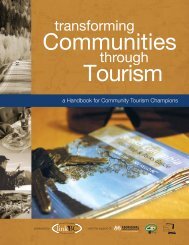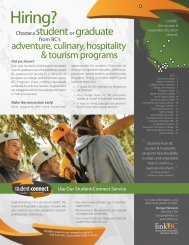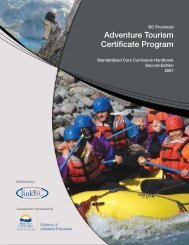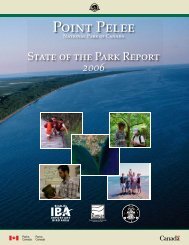Cultural Heritage Tourism Handbook - LinkBC
Cultural Heritage Tourism Handbook - LinkBC
Cultural Heritage Tourism Handbook - LinkBC
- No tags were found...
Create successful ePaper yourself
Turn your PDF publications into a flip-book with our unique Google optimized e-Paper software.
6.3 Value the Role of Visitor Information Centres6.4 Create Effective Partnerships 39Many towns support tourism throughcentrally-located Visitor InformationCentres (VICs) with staff trained to answerquestions about the community and localarea. The VIC may be either a stand-alonefacility (perhaps in a heritage structuresuch as a former railway station) or part ofan existing operation (a hotel, gas station,or chamber of commerce office).VICs can be costly to develop. If your community doesn’t alreadyhave a centre in place, be sure to determine the most suitable andcost-effective type of visitor services to provide in your community.Instead of a Visitor Centre, some smaller communities may chooseto have unstaffed information kiosks and clear, highly visible mapsand signs. Many communities are now providing this informationthrough a range of mobile phone apps.For many tourists, the VIC is the first point of contact with the community,and will strongly influence first impressions. Make sure yourcultural/heritage tourism strategy involves the VIC (or equivalentservice) as a key partner.Key Elements of Successful Information CentresYour cultural/heritage tourism strategy can be given a real boostby a VIC that demonstrates these attributes:• Is attractive, well-located, landscaped and central; has prominentsigns and provides free parking (note: sometimes the existinglocation is not the best!)• Accentuates cultural/heritage themes and community brandthrough design, exhibits, art, sculpture, etc.historic photos).• Provides appropriate place and profilefor the local Aboriginal story, and the otherpredominant cultures of the region.• Has excellent signs directing visitors tothe centre and key attractions.• Offers a professionally-designed touristmap of the community and region,including reasons and incentives to stay(highlighting character and themes – seechapter 9).• Provides a good inventory, display anddistribution of tourism-related brochuresfor community and region.• Engages visitors through an effectiveinterpretation program (e.g., exhibits, interpretivesigns, plaques, brochures, murals,• Offers training and regular upgrading to provide skills and knowledgeto visitor information counsellors.• Has opening hours that are convenient for the large majority ofvisitors.• Suggests itineraries, and reasons to stay longer.• Provides good mobile coverage and free WiFi.• Provides booking services so visitors can make purchases onthe spot.Not only is the VIC a great place to spread the word about attractions,it’s the perfect data collection point. The VIC, along with yourprovincial/territorial tourism department or ministry, can provideyou with guidance on how to tie into existing visitor tracking. Thisdata will help you create visitor profiles and determine what kindsof information and services tourists are looking for. Recording thisinformation over time will allow you to observe any changes andrespond accordingly, perhaps by updating the community tourismplan and the cultural/heritage tourism strategy.Now we invite you to consider approaches to building effective partnerships between culture,arts, and heritage agencies. Informal talks often lead to alliances, but when substantial investmentsof time, money, and reputation are involved, careful strategic thinking will lead to decisions thatowners and/or boards will later celebrate! Remember to:1. Ensure you have executive support for exploringthe development of cultural partnerships.Evaluate your organization’s capacity to manage relationships witharts, culture, and heritage partners. Is there the operational capacityto take on partners? Do you and your prospective partner have acore volunteer base? Is your current mix of products and servicesadaptable to new initiatives? Has your competition developedsimilar partnerships to the ones you are contemplating? Have youdeveloped a rationale for spending time and effort to move in thisdirection?2. Talk to colleagues in other destinations stronglyallied with the arts, culture, and heritage sector.Assemble some case studies, analyze demand trends, and undertakea competitive analysis. Don’t keep ideas a secret–sharing your thoughts at an early stage can helpyou develop a ‘guiding coalition’ of champions foryour new direction. You’ll also be able to identifywhere resistance within your organization or communityis likely to occur, and you might as wellfind these roadblocks early on!3. Evaluate your customer servicereputation and capacity.Poor customer service provided by your partnerscan reflect negatively on your own organization.Generally speaking, volunteer-run organizationsare often really successful at customer servicebecause of community enthusiasm for specialcultural events and attractions. Either way, here’swhere some due diligence up front can preventpotentially awkward alliances and steer youtowards mutually beneficial discussions.4. Schmooze! Do lunch!Talk to the people who are passionate about their culture/arts/heritage operations, because it’s their commitment that will makefor a solid partnership and growth of new cultural attractions andevents. Informally try out ideas for collaboration and see if there’s agood fit. Frequently, you’ll find dedicated people who want to seethe cultural life of their community build, who understand funding,political support, and volunteer development. If there is already amovement promoting arts and culture then it’s a good bet therewill be an appetite for expansion if the right partner comes along.5. Make one person responsible for managing relationshipswith cultural partners.Create a job description for a cultural tourism coordinator, and initiatethe role using a relatively low risk pilot project. The person fillingthat role needs to be a ‘champion’ (it might be you!). In some cases,a partnership may develop with very little forethought, but mostoften strategic alliances will include big players such as a DMO orcommunity association. These partners will want to reach out to asingle contact who can talk numbers, budgets, and goals.44 45










